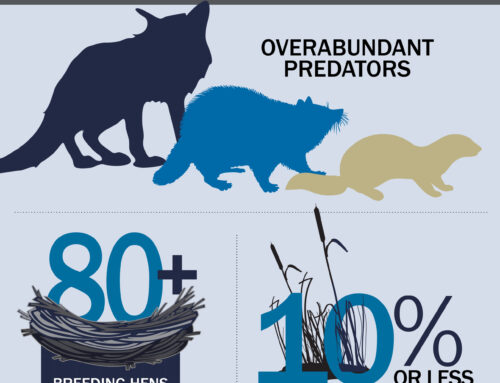How to Determine a Mallard’s Age

By Kyle Wintersteen, Managing Editor
Its head was Christmas green, its bill as yellow as the sun, and more than 20 years later I recall how my hands trembled with adrenaline as I clutched it, my first drake mallard. My questions were many. Among them, how old was the duck?
“It’s pretty easy to tell adult mallards from juveniles,” my mentor said. “The juveniles are the ones that decoy.”
I’ve since learned it’s not quite that easy — and determining an exact age is best left to biologists — yet I’ve retained interest in gauging whether my ducks are adults or juveniles. Primarily the habit owes to my fascination with waterfowl, but there’s also a certain sense of pride in knowing you bagged a wary adult drake.
 The wing feathers provide all necessary clues, but the characteristics to ponder vary among species. So, let’s focus on the most widespread and commonly bagged ducks in North America: mallards. Here are the simplest methods to identify juvenile and adult greenheads.
The wing feathers provide all necessary clues, but the characteristics to ponder vary among species. So, let’s focus on the most widespread and commonly bagged ducks in North America: mallards. Here are the simplest methods to identify juvenile and adult greenheads.
Edged Feathers
The presence of edging — a thin, light colored border surrounding certain wing feathers — is a key indicator of juvenile drakes for several species. However, note that edging can be present on hen mallards of any age.
For drake mallards, look for edging on the primary coverts (the first line of feathers above the primaries) and the middle and lesser coverts (located on the upper third of the wing). In adult greenheads, the coverts are essentially a solid mass of gray/brown, whereas many juveniles’ coverts are individually distinguishable due to the lightly hued edging.
If you find edging, you know for certain you’ve shot a juvenile drake. If you don’t, you might have killed an adult, but some juveniles also lack edging. Further confirmation is required.
Shape of Middle/Lesser Coverts
Regardless whether you’ve shot a hen or drake, one of the most foolproof ways to determine an adult mallard is to analyze the shape of its middle and lesser coverts. If they’re broad and rounded, you hold in your hands an adult mallard. On the other hand, if your duck’s middle/lesser coverts are shaped like triangles or trapezoids, these are obvious signs of a juvenile duck.
Tertial Feather Width
Finally, examine the tertials, a small collection of long, angled feathers between the secondaries and the body of the bird. Juvenile mallard tertials are narrow, brownish in color and often somewhat tattered in appearance. Adult mallard tertials are broader, grayer in color — especially among drakes — and typically in more pristine condition.
Note that the “tertial test” is only reliable in the early season. Juvenile mallards typically replace their tertials by December with adult-like feathers.
Regardless the age of your bird, congrats: Few mallards are easily earned.






[…] How to Determine a Mallard’s Age By Kyle Wintersteen, Managing Editor Its head was Christmas green, its bill as yellow as the sun, and more than 20 years later I recall how my hands trembled with adrenaline as I clutched it, my first drake mallard. My questions were many. Among them, how […]
I have a back yard marsh area with a water ditch threw it, grass banks, for 35 years I have watched the Mallard Duck with 2 females, come and mate. They hatch many little ducks. The last 4 years the Male Mallard has only arrived with one female. Could it be possible they are that old?? Would new Mallards come to the spot?? If they mate for life, and one died would he just stay with the one,?
Just check the tail feathers. If they are pointed it’s a mature bird. If they are rounded it’s a immature bird.